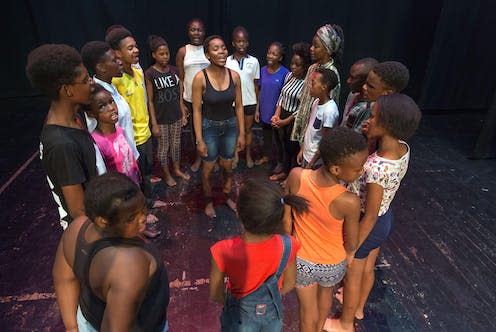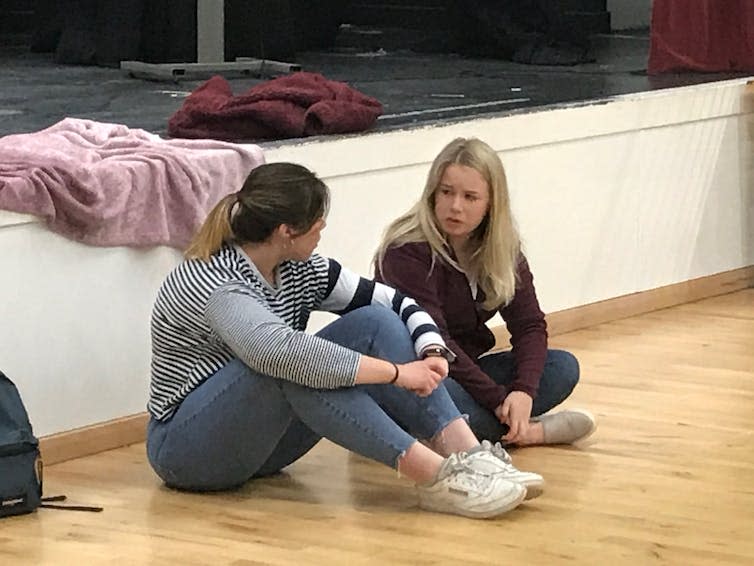How drama can help open up conversations on suicide for young people in post-pandemic times

Suicide is the second highest cause of death in 15-to-29-year-olds around the world, according to UK charity Young Minds, an organisation set up to help children and young people with mental health issues.
Many young people have experienced problems with their mental health during and since the COVID-19 pandemic, which is predicted to lead to a mental health epidemic. Factors such as the move to home schooling, physical isolation from friends and uncertainty over easing of restrictions have all contributed to poor mental health. But my research has shown that using drama to explore these sensitive issues could be one way to tackle the emerging crisis.
Against the pandemic backdrop, it is likely that there will be a rise in young people attempting suicide and, in some cases, taking their own lives. Recent research has found that 7% of British children have attempted suicide by the age of 17.
So there is an urgent need for early intervention and prevention strategies to be devised and implemented in schools to reverse the potential increase in suicide amongst young people.
In 2019, as a lecturer in performance, I carried out a drama research project in South Ayrshire schools which aimed to change attitudes towards talking about suicide. Contrary to popular belief, if there are serious concerns about someone’s safety, asking them directly if they’re contemplating suicide is recommended by mental health charity Mind.
This project, part of a Public Health Scotland strategy, was called Read Between The Lines and aimed to spread this message to young people in the hope of opening up conversations about suicide. My current research aims to develop the work done in Read Between The Lines and, after the restrictions of COVID-19, learn lessons from digital innovations in teaching and learning in addressing mental health issues around suicide.
The play’s the thing
In Read Between The Lines, a short play was presented to an audience of 11-to-18-year-olds which showed the difference talking can make in keeping young people safe. In the play, a teenage girl shows signs of contemplating suicide.
By talking to a friend, she is supported through her difficulties and ultimately turns away from the idea. Using drama to represent such difficult and sensitive conversations allowed the audience to explore these issues in a safe and supportive space.
Without such opportunities to talk freely about subjects like suicide, young people might otherwise be drawn to other fictional and sometimes sensationalised depictions of suicide. Following criticism from mental health organisations, in 2019 Netflix removed a controversial scene from its show 13 Reasons Why which showed a character taking her own life.
Acknowledging the potential vulnerability of some young people, Netflix then developed a website which offers support for a range of mental and physical wellbeing issues. Despite such resources, there is a need for more direct local responses to suicide prevention education using both digital and in-person approaches.
Building on the Read Between The Lines project, I am currently exploring ways of using digital resources, such as those developed by Grassroots Suicide Prevention. This resource, largely aimed at men, is a good example of how conversations on suicide can be generated safely.
But using such digital resources is only part of an effective approach; role playing with young people can be also a powerful tool to bring about change. This is why I believe that drama is one of the best ways to reach young people and help them talk comfortably about issues such as suicide.

Drama: inhabiting different worlds
Brazilian theatre director and activist Augusto Boal argued that drama can allow two worlds to be simultaneously inhabited, which he describes as “metaxis”, meaning that someone can play a role without getting lost in a character or situation. In this way, individuals can explore difficult and challenging scenarios.
For Boal, being an active participant is a powerful tool in bringing about change. In a similar way, Dorothy Heathcote’s pioneering drama education work of the 1970s placed children in the role of expert in exploring a range of topics.
In a BBC documentary from 1971, a child reflecting on one of Heathcote’s sessions commented that she’d rather explore a drama of her own making rather than a play because “a play is not our own words”. Allowing the children to play out their own (real) world through their own (imagined) drama world is an essential ingredient in Heathcote’s approach and one that helps bring about dialogue.
Drama can produce meaningful and productive dialogue about suicide and the mental health issues around it, as both my own and Heathcote’s work demonstrate. Heathcote’s use of dramatic spaces allows roles to be assumed intuitively, where the relationship between “expert” and “learner” is equally balanced.
In doing so, the boundaries between the expert and the learner become blurred which helps to develop spaces and communities where proper, ongoing dialogue actually happens.
A delicate balance is necessary when dealing with sensitive topics like suicide if it is to help nurture a society where young people can talk and listen to each other. The exploratory nature of drama offers a way to build such an environment and a promising way to tackle a mental health crisis in which lives are needlessly lost.
If you’re struggling with suicidal thoughts, the following services can provide you with support:
In the UK and Ireland – call Samaritans UK at 116 123.
In the US – call the National Suicide Prevention Lifeline at 1-800-273-TALK (8255) or IMAlive at 1-800-784-2433.
In Australia – call Lifeline Australia at 13 11 14.
In other countries – visit IASP or Suicide.org to find a helpline in your country.
This article is republished from The Conversation under a Creative Commons license. Read the original article.

James Layton does not work for, consult, own shares in or receive funding from any company or organisation that would benefit from this article, and has disclosed no relevant affiliations beyond their academic appointment.

 Yahoo Movies
Yahoo Movies 
